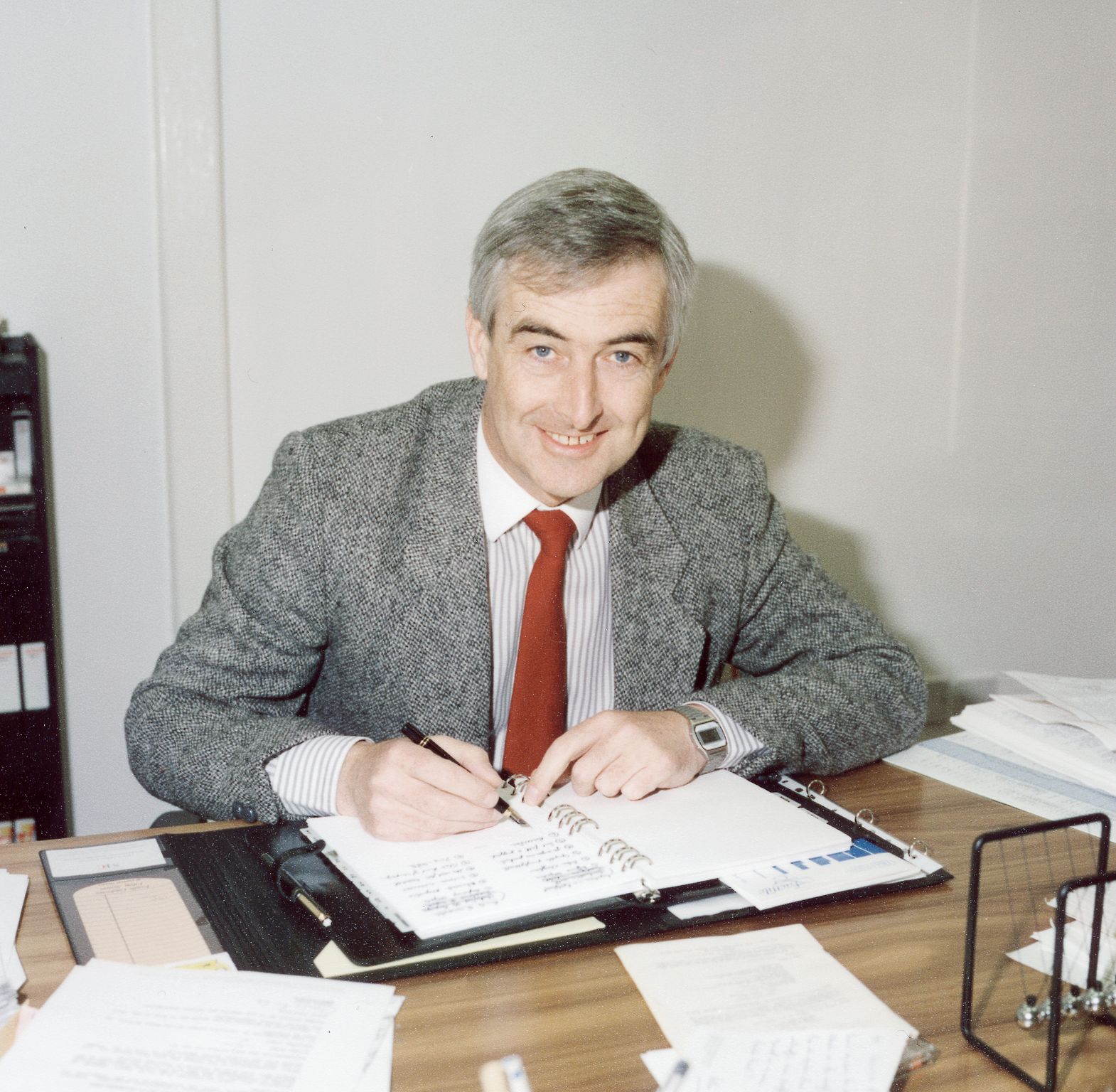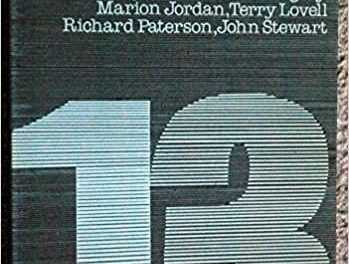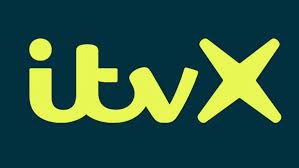- https://rts.org.uk/article/euryn-ogwen-1943-2021
- https://nation.cymru/news/giant-of-welsh-broadcasting-euryn-ogwen-williams-passes-away/
For anyone who had dealings with Euryn, he was also a stupendously positive human being. To have a chat with Euryn was to enjoy the brilliant sunshine of his undivided attention, and to emerge re-energised and with a new view on whatever project or aspect of life that had been raised. In Welsh broadcasting – an often frustrating and difficult area of cultural life – Euryn lifted the clouds, gave confidence and made the seemingly impossible, possible. These gifts were perhaps most apparent at the beginning of S4C, and it this time that this interview recalls.
S4C was launched on November 1, 1982 – the night before Channel 4’s launch – and Euryn Ogwen, as head of programmes, was responsible for constructing the new channel’s first hour. I was ten years old, and watching the first hour in the office of my father’s television company, Screen ’82, in Aberystwyth. 30 years to the day, Euryn and I met at the National Screen and Sound Archive in Aberystwyth to watch the channel’s first hour once again, and to decipher what Euryn called, it’s ‘hidden messages’. The conversation that follows seeks to dig beneath the surface of the first hour to analyse the roots of the channel, and to reflect on the thinking, the preparation, and the random elements that led to the composition of the first hour of S4C.
PART I
In this first section Euryn Ogwen discusses the beginnings of S4C, and the specific meaning and genealogy of the logo, taking us up to the very first second of the new channel, Sianel Pedwar Cymru…
Dafydd Sills-Jones: Ready?
Euryn Ogwen Williams: Ready. It’s the first time in thirty years that I’ve seen this…
DFS: Before starting to watch S4C’s first hour, let’s discuss what was going on exactly where you were when you watched the first hour for the first time? What had happened the day before, and the days immediately before the channel launched in November 1982?
EOW: I don’t remember everything, so I better not create the myth unduly, but the one thing I remember was that we were recording it. It was filmed in parts instead of using live cameras, because we wanted to be safe that it would go out right. We had to avoid anything going wrong. This was because of the notoriety in the Welsh tradition, certainly in my generation, of the launch of Harlech TV before it was changed to be HTV, which was disastrous. It wasn’t quite as bad as Granada’s launch in the 50s. At the launch of Granada, they got this famous guy from Canada, and they flew him over to present the programme. The night’s programming started at 6 o’clock, and they had been practicing it since about 11.00, and by 6pm the guy was totally drunk, he was not able to stand! It was a disaster.
The great Welsh disaster was Harlech’s first night, when they brought some important director from London. I’m sure he knew what he was doing, but he didn’t know the people, nor the studios, nor the story they were trying to create, and they filled the studio in Bristol with the likes of Richard Burton, Liz Taylor – they were all there, the celebrities – and then there were some more in Cardiff, but Harlech had just taken over, and no one had checked whether Cardiff and Bristol could link to each other … the night went from bad to worse, it was a shambles.
DFS: They were trying to do two live broadcasts at the same time?
EOW: There was one live broadcast, going through Cardiff to Bristol, and then out. For a while the only thing going out was a lone presenter in a small studio in Cardiff saying, “and any minute we will be going to Bristol … the dancers are there, the band is there, Geraldo and his orchestra are there, but we are unable to make contact … “.
So, whatever it was going to be, the opening programme on S4C was not going to be a live show. It was the start of semiotics – Umberto Echo’s stuff on the new science of “signs and signals” – he was in our minds, and the decision was made that the first hour would give clear indications of S4C’s identity, because a number of people were claiming different things in its name. You had one group who thought that S4C needed to be wholly Welsh, although it wasn’t and couldn’t be. There was another faction, the old broadcasters, who believed they were running it, so we had to put that straight. Also, another important sign I was trying to put out was that we were small, and we did not follow the pattern of traditional broadcasters, of being far removed from the audience.
We wanted the audience to feel part of the channel. And also, we had used Super Ted as the vehicle to create a buzz, especially among children, that there was something new about to start. We only had one episode of Super Ted! It took longer than we’d expected to create the animation, so somehow, we had to put it somewhere clearly enough to signal that Super Ted was coming, because we know we would have to wait until the next year to get a complete series of Super Ted.
So, there was all this to insert, somehow, into that first hour. Some sort of semiotics study of that first hour would be very interesting.
DSJ: Okay then, let’s go! [plays DVD].
Right, we have to stop after 7 seconds, with the first plate; i.e., the list of programs on the first night.
DSJ: Looking at the schedule here which opened the channel, the first hour there is quite mysterious, namely “6-7, Croeso i S4C, welcome to S4C”.
EOW: It’s interesting that it’s in both languages. Another interesting thing to notice about it is the logo on the bottom.
We had launched this a few months earlier because we knew were going to create a problem for part of the audience with the concept, the ‘brand’. We thought a long and hard about where we were going with it. We had chosen a company to create the logo; Chris Grace, who was responsible for the schedule, and I knew a boy who had founded a new company, namely Martin Lambie-Nairn. We knew him from when he worked for London Weekend Television. We went to him. I did ask for one or two Welsh companies to give us ideas, but nothing exciting came of it. We went to Martin, as his company had just started, and asked him to present us three ideas about which direction we should go.
We went for Martin, without knowing that he has pitched to do the Channel 4 logo, and he won that too. We got him before Channel 4, but this probably says a lot about the relationship between us and Channel 4.
DSJ: From looking at this, it is very interesting that ‘Wales’ is in front of ‘Cymru’, and then there’s ‘Wales 4 Cymru’, which almost has the sense that the English language faction of Wales are championing the Welsh language faction. Was that deliberate?
EOW: You’re right, all that stuff was in it.
DSJ: In a contemporary situation, when doing something like this for the Welsh community, it is almost inevitable that the Welsh would come first. Was putting English first less controversial in the early 1980s than it would have been today?
EOW: That was one of the arguments: can we use this at all. It worked well, and it is likely that only Martin, from outside Wales, could have seen that possibility. Of course, when the logo moves the English and Welsh language elements disappear, leaving only ‘S4C’. And then the ‘S4C’ in the middle is what people normally see.
DSJ: So, that was the first message?
EOW: The first message was the logo, and we stopped after only two seconds. Then to continue, on the first night, at seven o’clock was Newyddion Saith [News at Seven] for the first time ever, from the BBC. At half past seven, Cerdded Ymlaen [Walk On], with Dafydd Iwan; Patriotic, connecting S4C with the revolution which had brought it about, in the form of a music programme made by HTV. At 8 o’clock there was a news on sitcom [Newydd Bob Nos / New Every Night], which was an idea from a London production company pitched to S4C and Channel 4, and we decided to work together to create a Welsh version and an English version, because outside the BBC and HTV there was no tradition of comedy among the independent sector.
But there were many individuals who want to start producing comedy, and we felt that they needed to be trained, and the best training was to work on this program, and we used the same actors – Dyfed Thomas, Nia Ceidiog – in Welsh and English. They were recorded back-to-back, and the programme was ahead of her time, without being great. Some years later Channel 4 commissioned Drop the Dead Donkey, and there was a lot of this early programme in that production. It was a new episode every night, and has been created independently.
The choices made here were therefore a statement to the production sector; BBC, you are still doing the news; HTV, you’re going to get a programme at seven thirty; but then we are going to go to the independents. The two English programmes – Max Boyce and the Dallas Cowboys and the famous film Network had come to us because of the kindness of Channel 4, as we were launching the night before them. They felt that we needed to have free run at our launch.
DSJ: So those two programmes were in their first night too?
EOW: Yes they were, so they were seen in Wales the night before they were seen in England, and we had our choice of what to show from Channel 4’s output.
DSJ: that was quite generous, considering that Newydd Bob Nos, and Max Boyce were either gifts or co-productions with Channel 4.
EOW: there is another significant ‘sign’ about the relationship with Channel 4. It is hard now to imagine how things were then, but it was said clearly in Parliament, in one of the select committees – perhaps Leo Abse’s[1]? – it was said clearly be broadcasting specialists that the only way of executing the act that brought S4C into being was by opting out of Channel 4 programmes. Therefore, at 7pm, S4C ran its own programmes, but at 9pm – bam, at the exact time – we went back to Channel 4 programmes.
DSJ: In a similar way to ITV’s system with its regions?
EOW: Exactly. Of course, we had no intention of doing this, and once again Channel 4 agreed, even though they needn’t have agreed with us. The support from broadcasters and politicians was mostly for S4C to have an opt-out, but we were determined to go for an opt-in.
DSJ: Why?
EOW: We didn’t know what the exact length of the programmes should be. We didn’t want to finish every night at 9pm, because some programmes did not work before 9pm. We wanted to show sports, and without the certainty that a game would end on time, we would either have to break the act or end the programme in the middle of the game, or something like that. Practically it was impossible, but in addition we wanted to establish our independence, that we weren’t a regional opt-in. Fair play, that was part of the package, and because Channel 4 had agreed, we were able to in our first night that we were not going to go back to Channel 4 at 9pm, that we were going to show Channel 4 programmes when it suited us, not on the same night as Channel 4, and some of the programmes Channel 4 had at 9 we would not show because they were not relevant. This is all in this first caption.
DSJ: What about Max Boyce? Choosing the Max Boyce programme from Channel 4 was interesting, as he was a network figure at the time on the BBC wasn’t he – he wasn’t a Welsh language figure was he – and showing a programme about him going to America was suggesting ‘Wales in the world’ as it were?
EOW: Exactly, there were a lot of things in that first hour that sought to underline that view.
DSJ: Right, let’s continue with the DVD…
EOW: as the video runs towards the zero, there was a guy from Llanelli, Steve Rhys, and he had the job of pressing the play button because this was all pre-recorded, and then at 6 he would feed the programmes in, and as the tape was playing, we could see the new headquarters. Despite being a very small building, it was possible to make it look huge through the magic of Television!
— END OF PART I —
Dafydd Sills-Jones is Associate Professor in the School of Communications at Te Kura Whakapāho, Te Wānanga Aronui o Tāmaki Makau Rau (Auckland University of Technology). Before taking up this post in 2018, he was Lecturer in Media Production Cultures and Director of Postgraduate Studies in the Arts Faculty of Aberystwyth. Dafydd is co-editor of Peter Lang’s ‘Documentary Film Cultures’ book series, is on the editorial board of Media History (Taylor & Francis), The International Journal of Creative Media Research (Bath Spa University), and is a member of the International Association for Minority Language Media Research (IAMLMR).
Web: https://academics.aut.ac.nz/dafydd.sills.jones
Footnotes
[1] Leo Abse was an oponent of Welsh devoluation, and a sceptic regarding Welsh language revitalisation. He was Chair of the UK Parliament’s Welsh Asfairs Select Commitee from 1980-81. https://members.parliament.uk/member/662/career







